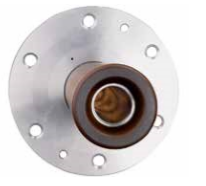
Dry-type RIP Insulation
Moser Glaser researched a way to increase the dielectric characteristics of its High Voltage equipment. As a result, Moser Glaser invented the Epoxy Resin Impregnated Paper (RIP) technology in 1958. With more than 50 years of experience in the development of RIP technology, Moser Glaser offers transformer bushings DURESCA® DTOIA from 25 to 345kV.
The insulation lays directly on the conductor or tube and consists of crepe paper dried under vacuum and impregnated with epoxy resin. Conductive grading layers are embedded during the winding of the insulation for the best field control. This guarantees the highest operational and human safety.
A strong moisture barrier prevents any contamination or moisture ingress. Moser Glaser design does not use any oil; DTOIA is completely dry and free of partial discharge. DTOIA bushings can be applied at any position from 0° to 90° from vertical and allow for safe horizontal transport and storage.
Moser Glaser pioneered the standardization of Silicone Rubber Insulators on Bushings, bringing a high level of safety and reliability to the Electric Utility industry and increasing the performance of the bushing in heavily polluted environments. Weight reduced as well as flexible sheds, increase its tolerance to vandalism, or earthquakes. No risk of porcelain break during shipping or handling; no collateral damage. Moser Glaser standardized on a minimum 54mm/kV of nominal line-to-ground voltage creepage distance.
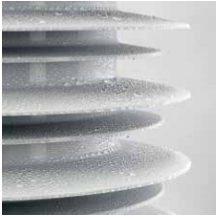

Moser Glaser can interchange a wide variety of bushings designs. This allows the customer to replace existing OIP bushings with RIP technology. The supply chain is simplified as the silicone molding operation is done in-house, Moser Glaser can offer short lead times for its standard range of products.
The main performance and life expectancy restraint in RIP condenser bushings were found to be the paper itself. Paper is an organic material with inconsistent material parameters, namely the moisture content. Too much moisture will cause high loss values, degrade the insulation system of the bushing, and possibly cause a premature failure. In order to compensate for this, modern RIP bushings utilize drying systems during the manufacturing process.
For shipment and storage, plastic bags with a dessicate bag or oil containers are used to protect the bushing. Finding an alternative material to paper was not an easy task, though, due to the fact that paper provides good insulation characteristics and has been used in bushing and transformer manufacturing processes for many years with continual optimization.
everal experimentations were needed to find optimal successor.

Moser Glaser undertook this task by performing tests on many materials in order to find a successor to the paper. After research, Moser Glaser found a special polyester structural material which is an excellent alternative to paper. Moser Glaser performed a sequence of tests to qualify this solution:
Routine and type tests according to IEC 60137-ed7.0 and IEEE C57.19.00-2004 Specifications for the type tests were beyond the requirements of the standard.
In addition, several special tests have been developed to challenge this solution.
-Adhesion test of direct moulded silicone on the RIS insulation
-Special humidity test
-Dynamic cantilever load tests
-Temperature cycle test
-Accelerated ageing test under high voltage

The new Resin Impregnated Synthetic RIS is now developed and part of Moser Glaser products portfolio.
An all-inclusive solution!
The result of this development is an ideal association of existing epoxy resin technology and its appreciated characteristics...
enhanced with new features:
-Partial discharge free
-Installation at any angle
-Self-extinguish material (no risk of fire)
-Shorter production cycle
-Easier handling for long transportation and storage
-Reduced power factor and capacitance
-Not affected by humidity
For outdoor application, Moser Glaser standardized a direct-molded silicone insulator to provide an, even more, safer solution. Moser Glaser could maintain its strength by providing a high level of customization. Therefore RIS technology can be applied to the standard range and also can interchange all existing designs. There is no limitation as for the diameter and length. What you get today with RIP technology can be offered with RIS. With this important new milestone, Moser Glaser is now ready to offer the bushing of the future

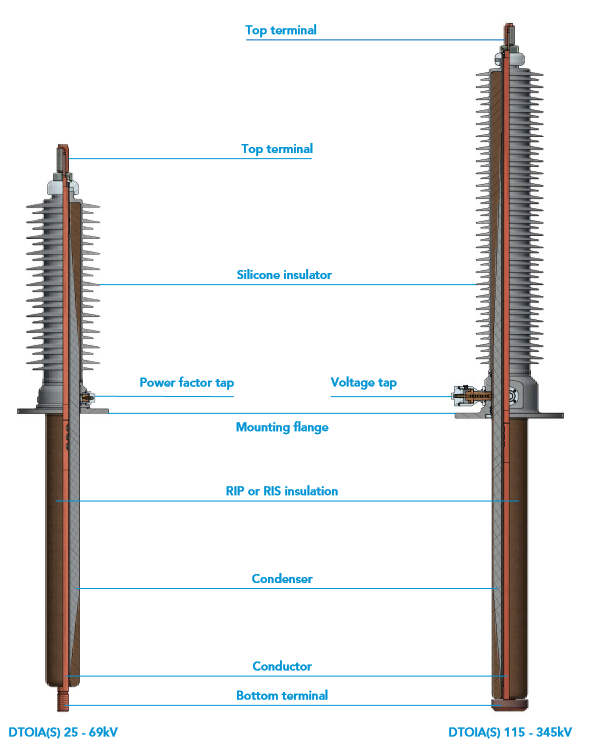
All technical data (electrical and dimensions) from this catalog are applicable for RIP as well as RIS insulation.
-Bushings with RIP insulation are denominated as DTOI
-Bushings with RIS insulation as DTOIS
Top Terminal
-DTOIA(S) bushings are delivered with a top terminal in copper silver plated. It's bolted to the head of the bushing for the Draw-lead and Draw-rod type or part of the conductor for the Fix-conductor type.
-NEMA top terminal pad can be offered as an optional accessory
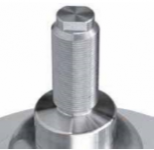

-Moser Glaser offers various possibilities of Draw-lead connectors to ensure full interchangeability in case of bushing replacement.
-DTOIA(S) Draw-lead bushings do not require additional shielding up to 161kV.
-The right selection of the cable size is the responsibility of the transformer manufacturer.
-The Draw-lead has to be insulated to isolate it from the bushing center tube.
-More details are given on page 8.
-Moser Glaser offers extended bushing flexibility and ease of use through the use of a Draw-rod conductor.
-A split copper rod allows easy installation and removal without lowering the oil level, while also providing current ratings beyond draw-lead ratings
-Used for bushings with the highest current ratings. A man-hole on the transformer is required to access the connection.
-The bushing can be equipped with a removable corona shield as an optional accessory.
-The bushings withstand a short-time current of 25x rated continuous current for a maximum of 2 seconds.
-For Draw-lead the short-time current is defined according to the cable cross-section in mm²: Ith 2sec (kA)= 0.06 x S
Made of corrosion free aluminium, equipped with
-Lifting holes
-Power factor tap (all ratings)
-Voltage tap (for 115kV and above)

-The current rating gives the maximum continuous rating with no effect on the bushing lifetime. Draw-lead; 800A Draw-rod; 1200A (up to 161kV) Bottom connected; 2000A and above.
-Bushing rating, as well as cable size, has to be chosen at least 20% above transformer rating.
-All bushings have a Power factor tap. The tap is connected to the ground layer.
-The grounding is done through the cap. The test voltage is 2kV, 50Hz for 72sec.
-115kV and above are additionally equipped with a 20kV Voltage tap. It’s connected to one of the inner layer from the C1 condenser.
The Draw-lead connector is equipped with a pilot hole. It has to be drilled according to the lead diameter. The maximum cable section is 400mm² up to 161kV and 500mm² for 230kV. The cable is connected to the Draw-lead connector via brazing and draw through the bushing center tube. The maximum current rating is 800A.
-When no information is given to Moser Glaser, this one will be the default choice.
Part number will be the drawing number with the extension .B01 Ex.: 600.17.0004.B01 for a DTOIA 25kV – 800A

An alternative brazed solution is offered for Draw-lead bushings. The apparatus cable is directly brazed on the Draw-lead connector spade. The maximum current rating is 400A up to 69kV and 800A for 115kV and above. Part number will be the drawing number with the extension .B31 Ex.: 600.17.0007.B31 for a DTOIA 34.5kV – 400A

The connector is adapted to Draw-lead size. The maximum current rating is 400A. Part number will be the drawing number with the extension .B21 to .B25 Ex.: 600.17.0013.B25 for a DTOIA 69kV – 400A

The most critical parameter to consider is the height above the flange of the existing bushing versus the replacement bushing. Below two solutions are then offered:
Moser Glaser offers lengthened Draw-lead connector (for brazing or crimping) to compensate for any difference in the length of the cable. When the customer wants to keep the existing configuration, Moser Glaser offers an adapter that threads onto the existing Draw-lead stud.
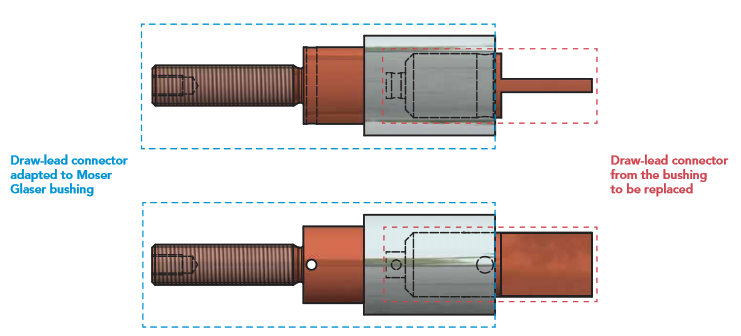
It is a quick and easy solution to correct the difference in height and avoid any additional brazing or crimping operation on-site. Ask Moser Glaser for more details about this solution.
This is a more complicated procedure requiring that the original Draw-lead connector has to be cut off at a specific point on the Draw-lead cable and either crimping or brazing on a new one. Thanks to its flexible manufacturing equipment, Moser Glaser can offer Draw-lead bushings with an extended strike distance and therefore compensate the airside length difference. Then this bushing can be equipped with a Draw-lead adapter as presented in solution 1 or a standard connector.
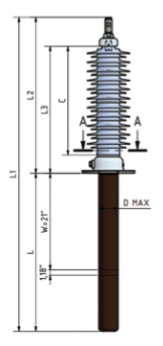
Capable to carry up to 800A by cable
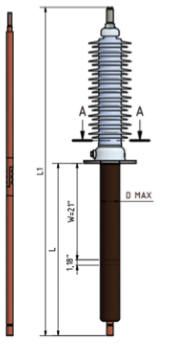
The Draw-lead type bushing is equipped with a Draw-rod to increase the current to 1200A

The conductor is fix type for ratings > 2000A

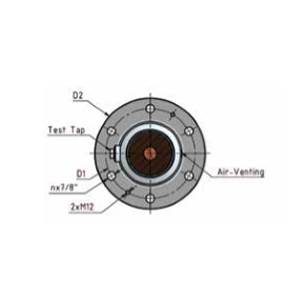


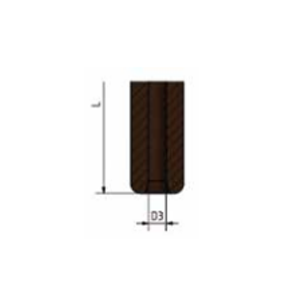


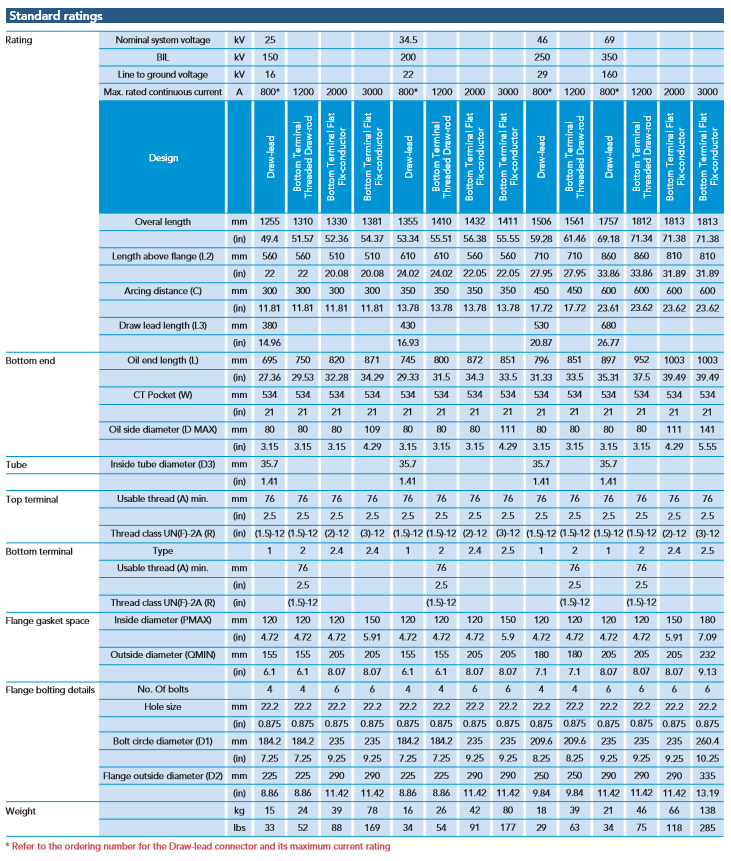
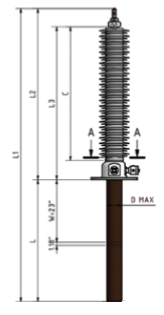
Capable to carry up to 800A by cable
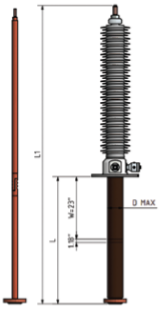
The same Draw-lead type bushing is equipped with a Draw-rod to increase the current to 1200A
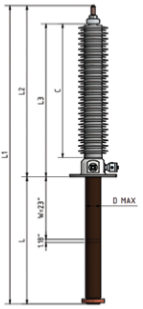
The conductor is fix type
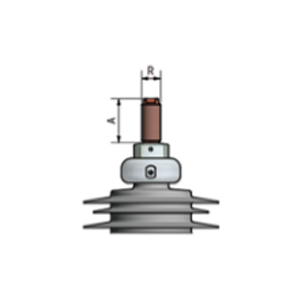
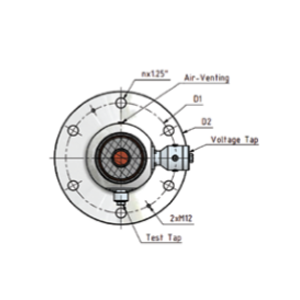
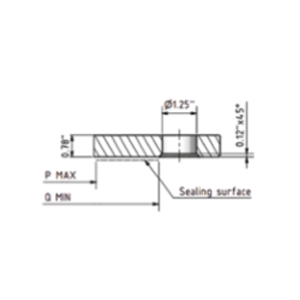
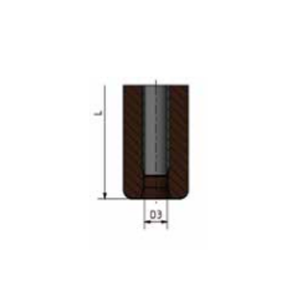
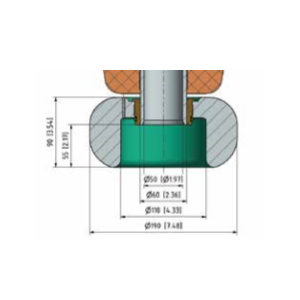


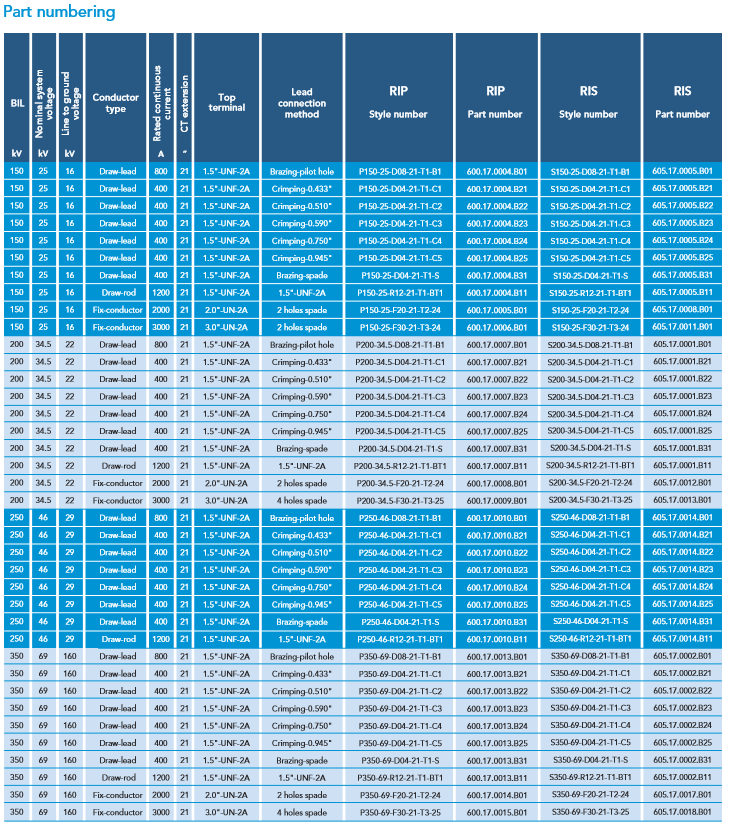
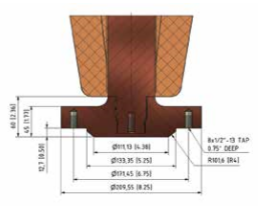

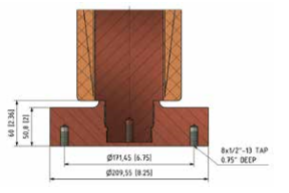
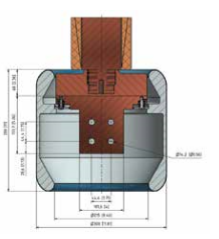
The distance to the grounded parts is depending on voltage, transformer tank design as well as oil condition, and quality. R7 distance is given in the dimensions table.
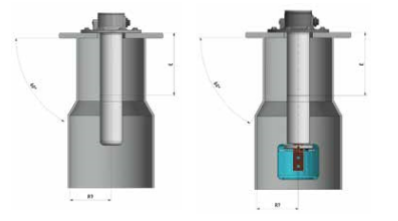
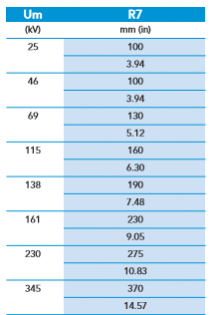
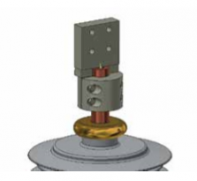
They are usually cast from aluminum but are also made on customer request from other materials (copper, brass). More details on request.
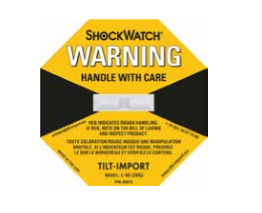
On request, a shock indicator label can be fixed on the crate to check if it has experienced a mechanical shock.
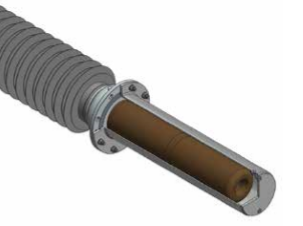
A protective tank is used to protect parts of RIP bushing which are used under service in transformer oil against damages or humidity. They are used for long-term storage as well as for protection during long transports. The protection tank is delivered mounted on the bushing and filled with dry insulating oil. After the sealing, an air cushion remains in the protection tank which is necessary for compensation purposes due to temperature-sensitive volume variations.
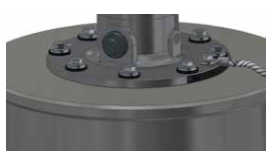
Moser Glaser has made investigations and performed tests according to ISO 12944 and ISO 20340 to find the most efficient combination of products for heavily corrosive environments. If you ordered a bushing for offshore application, the flange and the head of the bushing will be anodized, and the top terminal will be tin-plated. Additional mounting advices are given in our online instruction manual www.mgc.ch

Raptors Trading & Contracting has been established in February 2015 and it currently represents multiple reputable international brands. Our traditional business model is based on trading and contracting in the electrical engineering sector.
Quick Links
Contact Us
© Copyright 2024 Raptors Qatar. Proudly Powered by oxi-smart.net
WhatsApp us